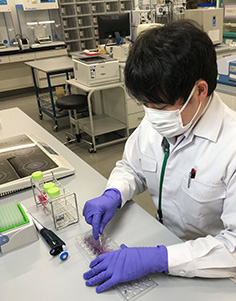Advances in life science technology and computational toxicology have led to the development of alternative methods to animal testing, such as the use of cultured cells. We are actively participating in joint research on alternative methods with domestic companies to develop and verify test methods, to ensure that our customers can use our products with peace of mind on animal welfare.

Oral mucosal irritation evaluation is legally required to develop quasi-drugs for the oral cavity. For skin and eye irritation evaluations, alternative testing methods for quasi-drug approval applications have been developed for the international test guidelines, but for oral mucosal irritation testing, no recognized alternative methods have been established. To address this issue, we are working with Kao Corporation and Sunstar Inc. to develop an alternative method for oral mucosal irritation testing that can be used in applications for the approval of quasi-drugs.
One method uses a human three-dimensional (3-D) model of cultured oral mucosa to determine whether a substance is an irritant or a non-irritant based on cell viability after exposure to the test substance with cytotoxicity as an indicator.
To develop alternative testing methods, it is necessary to verify validity using the existing chemical evaluation data (irritant or non-irritant). We have developed a testing method using a human 3-D model of cultured oral mucosa based on the results of accumulated oral mucosal irritation tests. As part of the verification, we evaluated 32 chemicals with known irritation test data for the ocular mucosa, which is composed of mucosal. We evaluated these chemicals using the newly-developed testing method and verified the consistency of the results. The resulting accuracy rate was calculated to be 87.5%, indicating the possibility that this testing method can accurately classify whether a substance is an irritant or a non-irritant.
In order to establish this testing method as an alternative method to be used for quasi-drug applications, we will proceed with the verification of scientific validity.